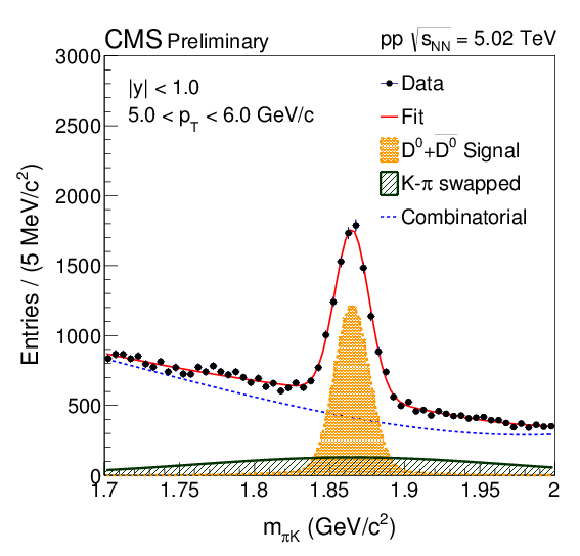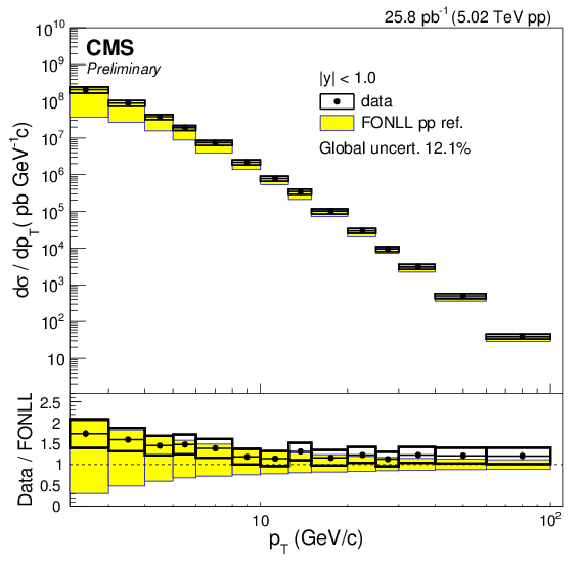

Compact Muon Solenoid
LHC, CERN
| CMS-PAS-HIN-16-001 | ||
| $\mathrm{D}^0$ meson nuclear modification factor in PbPb collisions at $\sqrt{s_\mathrm{NN}} =$ 5.02 TeV | ||
| CMS Collaboration | ||
| June 2016 | ||
| Abstract: $\mathrm{D}^{0}$ meson production has been measured in pp and PbPb collisions at $\sqrt{s_{_{\text{NN}}}}=$ 5.02 TeV in the central rapidity, $ |y|< $ 1 , and in the transverse momentum range between 2 and 100 GeV$/c$ with the CMS detector at the LHC. The proton-proton dataset used for this analysis corresponds to an integrated luminosity of 25.8 pb$^{-1}$, while the PbPb dataset corresponds to 404 $\mu$b$^{-1}$. The measured D$^0$ spectrum in pp collisions is well described by perturbative QCD calculations. The nuclear modification factor $\mathrm{R}_{\rm AA}$, defined as the ratio between the corrected PbPb yield and the proton-proton cross-section scaled by the number of incoherent nucleon-nucleon collisions, was also measured. In the transverse momentum range $p_{\rm T} =$ 6-10 GeV$/c$, the $\mathrm{D}^{0}$ yield in the PbPb collisions is suppressed by a factor of 4-5 compared to the scaled proton-proton reference. At high $p_{\rm T}$, the suppression is significantly reduced, approaching roughly a factor of 1.5 for particles with $p_{\rm T}$ in the range 60-100 GeV$/c$. The measured $\mathrm{D}^{0}$ nuclear modification factor is compatible with the charged particle $\mathrm{R}_{\rm AA}$, within the experimental uncertainties. | ||
|
Links:
CDS record (PDF) ;
inSPIRE record ;
CADI line (restricted) ;
These preliminary results are superseded in this paper, PLB 782 (2018) 474. The superseded preliminary plots can be found here. |
||
| Figures | |

png pdf |
Figure 1-a:
Examples of ${\mathrm {D}^{0}}$ candidate invariant mass distribution in pp (a) and PbPb collisions (b) at 5.02 TeV. |

png pdf |
Figure 1-b:
Examples of ${\mathrm {D}^{0}}$ candidate invariant mass distribution in pp (a) and PbPb collisions (b) at 5.02 TeV. |

png pdf |
Figure 2:
${p_{\mathrm {T}}} $-differential cross section of prompt ${\mathrm {D}^{0}}$ mesons in pp collisions at ${\sqrt {s}} =$ 5.02 TeV compared to the FONLL predictions [5]. |

png pdf |
Figure 3-a:
Nuclear modification factor $\rm {\rm R_{AA}} $ as a function of ${p_{\mathrm {T}}}$ in the centrality range 0-100% (a) and 0-10% (b). The inclusive charged particle $\rm R_{AA}$ results are superimposed for equivalent event selections [21]. The ${\mathrm {D}^{0}}$ ${\rm R_{AA}}$ are also compared to the predictions from various theoretical calculations [22,23,24,25,26,27,28,29,30]. |

png pdf |
Figure 3-b:
Nuclear modification factor $\rm {\rm R_{AA}} $ as a function of ${p_{\mathrm {T}}}$ in the centrality range 0-100% (a) and 0-10% (b). The inclusive charged particle $\rm R_{AA}$ results are superimposed for equivalent event selections [21]. The ${\mathrm {D}^{0}}$ ${\rm R_{AA}}$ are also compared to the predictions from various theoretical calculations [22,23,24,25,26,27,28,29,30]. |
| Summary |
| In this note, measurements of the prompt $\mathrm{D}^{0}$ production cross section and nuclear modification factor $\mathrm{R}_{\rm AA}$ in pp and PbPb collisions in the central rapidity region ($ |y|< $ 1) at $\sqrt{s_{_{\text{NN}}}}=$ 5.02 TeV from CMS are presented. The $\mathrm{R}_{\rm AA}$ of prompt $\mathrm{D}^{0}$ mesons is measured as a function of the $\mathrm{D}^{0}$ transverse momentum from 2 to 100 GeV/$c$ in two centrality ranges. The $\mathrm{D}^{0}$ $\mathrm{R}_{\rm AA}$ is found to be strongly suppressed in PbPb collisions when compared to the measured pp reference scaled by the number of binary nucleon-nucleon collisions. These measurements are consistent with the nuclear modification factors of charged hadrons in the corresponding centrality ranges. |
| References | ||||
| 1 | \'E. V. Shuryak | Theory of hadron plasma | Sov. Phys. JETP 47 (1978)212 | |
| 2 | J. C. Collins and M. J. Perry | Superdense Matter: Neutrons or Asymptotically Free Quarks? | PRL 34 (1975) 1353 | |
| 3 | Y. L. Dokshitzer and D. E. Kharzeev | Heavy quark colorimetry of QCD matter | PLB519 (2001) 199--206 | hep-ph/0106202 |
| 4 | N. Armesto, C. A. Salgado, and U. A. Wiedemann | Medium-induced gluon radiation off massive quarks fills the dead cone | PRD 69 (Jun, 2004) 114003 | |
| 5 | M. Cacciari, M. Greco, P. Nason | The $ p_T $ Spectrum in Heavy-Flavour Hadroproduction | JHEP 007, 9805 (1998) | |
| 6 | CMS Collaboration | Prompt and non-ptompt $ J/\psi$ $R_{AA} $ with 150 $ \mu$b$^{-1} $ integrated PbPb luminosity at $ \sqrt{s_{NN}} = $ 2.76 TeV | CDS | |
| 7 | CMS Collaboration | Evidence of b-Jet Quenching in PbPb Collisions at $ \sqrt{s_{NN}}=2.76 $..TeV | Phys.Rev.Lett. 113 (2014), no. 13, 132301 | CMS-HIN-12-003 1312.4198 |
| 8 | CMS Collaboration | Nuclear modification factor $ R_{pA} $ of b jets in pPb collisions | CDS | |
| 9 | CMS Collaboration | Study of B meson production in pPb collisions at $ \sqrt{s_{NN}} =$ 5.02 TeV | CMS-HIN-14-004 1508.06678 |
|
| 10 | CMS Collaboration | Centrality dependence of high-pT D meson suppression in Pb-Pb collisions at $ \sqrt{s_{NN}} =$ 2.76 TeV | Journal of High Energy Physics 2015 (2015), no. 11, 1--24 | |
| 11 | J. T. Adam | J. T. Adam | ||
| 12 | CMS Collaboration | The CMS experiment at the CERN LHC | JINST 3 (2008) S08004 | CMS-00-001 |
| 13 | GEANT4 Collaboration | GEANT4---a simulation toolkit | NIM506 (2003) 250 | |
| 14 | T. Sj\"ostrand, S. Mrenna, and P. Skands | PYTHIA 6.4 physics and manual | JHEP 05 (2006) 026 | hep-ph/0603175 |
| 15 | R. Field | Early LHC Underlying Event Data -- Findings and Surprises | in Hadron collider physics. Proceedings, 22nd Conference, HCP 2010, Toronto, Canada, August 23-27, 2010 2010 | 1010.3558 |
| 16 | I. P. Lokhtin and A. M. Snigirev | A model of jet quenching in ultrarelativistic heavy ion collisions and high-$ \pt $ hadron spectra at RHIC | EPJC45 (2006) 211 | hep-ph/0506189 |
| 17 | D. Lange | The EvtGen particle decay simulation package | Nucl.Instrum.Meth. A462 (2001) 152--155 | |
| 18 | E. Barberio, B. van Eijk, and Z. Was | PHOTOS: A Universal Monte Carlo for QED radiative corrections in decays | Comput.Phys.Commun. 66 (1991) 115--128 | |
| 19 | Particle Data Group Collaboration | Review of Particle Physics (RPP) | Phys.Rev. D86 (2012) 010001 | |
| 20 | CMS Collaboration | Measurement of tracking efficiency | CDS | |
| 21 | CMS Collaboration | CMS Collaboration | ||
| 22 | J. Xu, J. Liao, and M. Gyulassy | Bridging Soft-Hard Transport Properties of Quark-Gluon Plasmas with CUJET3.0 | JHEP 02 (2016) 169 | 1508.00552 |
| 23 | J. Xu, A. Buzzatti, and M. Gyulassy | Azimuthal jet flavor tomography with CUJET2.0 of nuclear collisions at RHIC and LHC | JHEP 08 (2014) 063 | 1402.2956 |
| 24 | X. Jiechen, L. Jinfeng, and M. Gyulassy | Consistency of Perfect Fluidity and Jet Quenching in Semi-Quark-Gluon Monopole Plasmas | Chinese Physics Letters 32 (2015), no. 9, 092501 | |
| 25 | M. Djordjevic and M. Djordjevic | Predictions of heavy-flavor suppression at 5.1 TeV Pb + Pb collisions at the CERN Large Hadron Collider | PRC 92 (Aug, 2015) 024918 | |
| 26 | G.-Y. Q. X.-N. W. Shanshan Cao, Tan Luo | A Linearized Boltzmann transport model for jet propagation in the quark-gluon plasma: Heavy quark evolution. | 1605.06447v1 | |
| 27 | T. Song et al. | Tomography of the quark-gluon plasma by charm quarks | PRC 92 (Jul, 2015) 014910 | |
| 28 | T. Song et al. | Charm production in Pb + Pb collisions at energies available at the CERN Large Hadron Collider | PRC 93 (Mar, 2016) 034906 | |
| 29 | Z.-B. Kang et al. | Jet Quenching Phenomenology from Soft-Collinear Effective Theory with Glauber Gluons | PRL 114 (Mar, 2015) 092002 | |
| 30 | Y.-T. Chien et al. | Jet quenching from QCD evolution | PRD 93 (Apr, 2016) 074030 | |
| 31 | S. J. S. M. L. Miller, K. Reygers and P. Steinberg | Glauber modeling in high-energy nuclear collisions | technical report | |

|
Compact Muon Solenoid LHC, CERN |

|

|

|

|

|

|